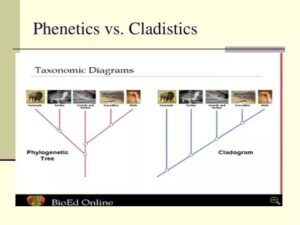Back to: ZOOLOGY 100 Level
Welcome back! Today, we’re diving into an exciting topic: phylogenetics and cladistics. These are tools that help scientists understand the relationships between different species and trace their evolutionary history. By the end of this lesson, you’ll know how we can tell how closely related different organisms are and how scientists classify them. Let’s get started!
Phylogenetics and basic cladistics
What Is Phylogenetics?
Phylogenetics is the study of the evolutionary history and relationships among species. It’s like creating a family tree but for all living organisms, not just humans. Scientists use this field to trace how species are related to one another, how they evolved, and when they shared common ancestors.

- For example, humans and chimpanzees share a common ancestor, which means that millions of years ago, there was an ancestor species that eventually evolved into both humans and chimpanzees.
- Phylogenetics uses genetic data (like DNA) and physical traits to understand these relationships.
What Is Cladistics?
Cladistics is a method used in phylogenetics to classify organisms based on their evolutionary traits. Cladistics groups species based on shared characteristics that come from their most recent common ancestor. These shared features are known as synapomorphies.
- For example, if two animals have similar traits like a particular type of bone structure or a similar genetic code, they are likely to have a shared common ancestor, and scientists will group them together in the same clade.
- Cladistics helps us understand how species are related in an evolutionary sense. It’s like drawing lines between species to see which ones share a family tree.

Basic Principles of Cladistics
- Clades:
A clade is a group of organisms that includes an ancestor and all of its descendants. Organisms in a clade share certain characteristics that originated from a common ancestor.- Example: The group of birds is a clade because they all evolved from a common ancestor that had feathers.
- Synapomorphies:
These are shared characteristics that evolved in the most recent common ancestor of a group of organisms and are passed down to their descendants.- Example: One synapomorphy for mammals is hair. All mammals have hair, and this trait is passed down from a common mammalian ancestor.
- Outgroups:
In cladistics, an outgroup is a species or group of species that is outside the group being studied (the ingroup). The outgroup helps scientists determine which traits are ancestral and which are derived.
- Example: If we are studying the relationship between different species of primates, we might use lemurs (which are more distantly related to other primates) as an outgroup to help understand evolutionary traits in other primates like humans and monkeys.
- Monophyletic Groups:
A monophyletic group is a group of organisms that includes a single ancestor and all of its descendants. This is the key to understanding evolutionary relationships in cladistics.- Example: The clade of reptiles includes lizards, snakes, turtles, and crocodiles, all of which share a common ancestor.

How Are Phylogenetic Trees and Cladograms Created?
Scientists use a tool called a phylogenetic tree or cladogram to visually represent the evolutionary relationships between species. These trees show the branching pattern of evolution, with each branch representing a common ancestor. Let’s break down how they are created:
- Identify Traits: Scientists first identify traits or genetic markers that are shared by species.
- Construct a Tree: The shared traits are used to build a tree that shows how species are related, with branches representing common ancestors.
- Interpret the Tree: The tree helps scientists understand the sequence of evolutionary events, how species are related, and where they diverged from each other.
Summary
- Phylogenetics is the study of the evolutionary history and relationships between species.
- Cladistics is a method used in phylogenetics to classify species based on shared characteristics from a common ancestor.
- A clade is a group of species that includes an ancestor and all of its descendants.
- Synapomorphies are shared traits that define groups of organisms.
- A phylogenetic tree or cladogram visually represents evolutionary relationships.
Evaluation
- What is the main goal of phylogenetics?
- Define cladistics and explain how it is used in studying evolutionary relationships.
- What is a clade, and how does it help scientists understand evolution?
- Explain the role of synapomorphies in cladistics.
- How do scientists use outgroups in cladistics?
You’ve done an excellent job understanding the fascinating world of phylogenetics and cladistics. These concepts help scientists make sense of the vast diversity of life on Earth and how everything is interconnected. Keep up the hard work, and I can’t wait to see what we learn next!
